
A sclerite is a hardened body part. In various branches of biology the term is applied to various structures, but not as a rule to vertebrate anatomical features such as bones and teeth. Instead it refers most commonly to the hardened parts of arthropod exoskeletons and the internal spicules of invertebrates such as certain sponges and soft corals. In paleontology, a scleritome is the complete set of sclerites of an organism, often all that is known from fossil invertebrates.
The radula is an anatomical structure used by mollusks for feeding, sometimes compared to a tongue. It is a minutely toothed, chitinous ribbon, which is typically used for scraping or cutting food before the food enters the esophagus. The radula is unique to the molluscs, and is found in every class of mollusc except the bivalves, which instead use cilia, waving filaments that bring minute organisms to the mouth.

Chitons are marine molluscs of varying size in the class Polyplacophora, formerly known as Amphineura. About 940 extant and 430 fossil species are recognized.

Tullimonstrum, colloquially known as the Tully Monster, is an extinct genus of soft-bodied bilaterian that lived in shallow tropical coastal waters of muddy estuaries during the Pennsylvanian geological period, about 300 million years ago. A single species, T. gregarium, is known. Examples of Tullimonstrum have been found only in the Mazon Creek fossil beds of Illinois, United States. Its classification has been the subject of controversy, and interpretations of the fossil have likened it to molluscs, arthropods, conodonts, worms, and vertebrates.

The Mazon Creek fossil beds are a conservation lagerstätte found near Morris, in Grundy County, Illinois. The fossils are preserved in ironstone concretions, formed approximately 309 million years ago in the mid-Pennsylvanian epoch of the Carboniferous period. These concretions frequently preserve both hard and soft tissues of animal and plant materials, as well as many soft-bodied organisms that do not normally fossilize. The quality, quantity and diversity of fossils in the area, known since the mid-nineteenth century, make the Mazon Creek lagerstätte important to paleontologists, in attempting to reconstruct the paleoecology of the sites. The locality was declared a National Historic Landmark in 1997.
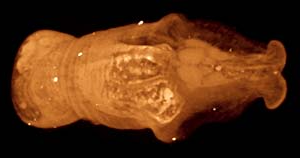
Aplacophora is a presumably paraphyletic taxon. This is a class of small, deep-water, exclusively benthic, marine molluscs found in all oceans of the world.
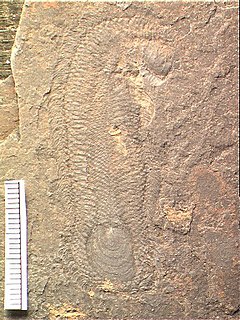
The halkieriids are a group of fossil organisms from the Lower to Middle Cambrian. Their eponymous genus is Halkieria, which has been found on almost every continent in Lower to Mid Cambrian deposits, forming a large component of the small shelly fossil assemblages. The best known species is Halkieria evangelista, from the North Greenland Sirius Passet Lagerstätte, in which complete specimens were collected on an expedition in 1989. The fossils were described by Simon Conway Morris and John Peel in a short paper in 1990 in the journal Nature. Later a more thorough description was undertaken in 1995 in the journal Philosophical Transactions of the Royal Society of London and wider evolutionary implications were posed.
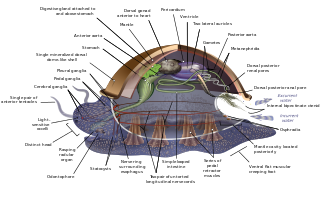
The evolution of the molluscs is the way in which the Mollusca, one of the largest groups of invertebrate animals, evolved. This phylum includes gastropods, bivalves, scaphopods, cephalopods, and several other groups. The fossil record of mollusks is relatively complete, and they are well represented in most fossil-bearing marine strata. Very early organisms which have dubiously been compared to molluscs include Kimberella and Odontogriphus.

Odontogriphus is a genus of soft-bodied animals known from middle Cambrian Lagerstätte. Reaching as much as 12.5 centimetres (4.9 in) in length, Odontogriphus is a flat, oval bilaterian which apparently had a single muscular foot, and a "shell" on its back that was moderately rigid but of a material unsuited to fossilization.
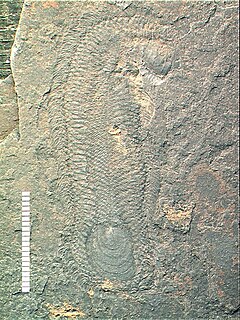
Halwaxiida or halwaxiids is a proposed clade equivalent to the older orders Sachitida He 1980 and Thambetolepidea Jell 1981, loosely uniting scale-bearing Cambrian animals, which may lie in the stem group to molluscs or lophotrochozoa. Some palaeontologists question the validity of the Halwaxiida clade.

Helenodora is an extinct onychophoran genus known from the Carboniferous Carbondale Formation of Illinois. The only known species described is H. inopinata.

Mollusca is the second-largest phylum of invertebrate animals after the Arthropoda. The members are known as molluscs or mollusks. Around 85,000 extant species of molluscs are recognized. The number of fossil species is estimated between 60,000 and 100,000 additional species. The proportion of undescribed species is very high. Many taxa remain poorly studied.
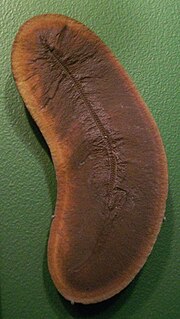
Pseudophlegethontia is an extinct genus of aïstopod lepospondyl. It is the only member of the family Pseudophlegethontiidae. The only species is the type species P. turnbullorum, named in 2003. Fossils of Pseudophlegethontia have been found from the Mazon Creek fossil beds in Grundy County, Illinois, a conservation lagerstätte well known for the exceptional preservation of middle Pennsylvanian taxa.
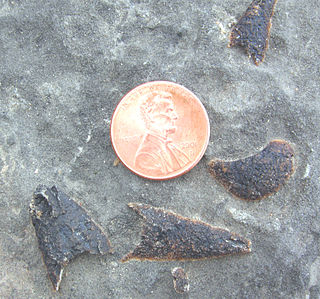
Matthevia is a genus of Cambrian molluscs, perhaps related to the chitons. It consists of repeated monoplacophoran-like shells; according to one hypothesis, chitons arose when these tall shells began to overlap over the generations. The tall element of the shell was retained and forms the tips of modern chiton plates. There are distinct head, 'centre', and tail valves, which occur approximately in the ratio 1:5:1 — suggesting a seven-plated configuration.

Hanleya is a genus of polyplacophoran molluscs known from Oligocene and Miocene fossils; it is represented today by a number of species including H. sinica Xu 1990 (China), H. brachyplax (Brazil) and H. hanleyi Bean in Thorpe, 1844 (Chile), which feeds on sponges.

Cyclida is an order of fossil arthropods that lived from the Carboniferous to the Cretaceous. Their classification is uncertain, but they are generally treated as a group of maxillopod crustaceans.
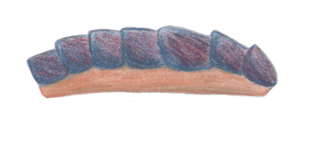
Kulindroplax perissokomos is a Silurian mollusk, known from a single fossil from the Wenlock Series Lagerstätte fauna of England. It lived during the Homerian Age. It is considered a basal aplacophoran. Unlike all modern aplacophorans, which are shell-less, Kulindroplax has a chiton-like shell, and it is considered a transitional fossil in the evolution of molluscs.
Phthipodochiton is an extinct genus of molluscs, known from several fossils from the upper Ordovician fauna of the Lady Burn Starfish beds of Girvan, Scotland. It shows a mixture of aplacophoran body plan and polyplacophoran-like valves, and it is an informative fossil in the evolution of aculiferan mollusks.
Rhombichiton is a genus of polyplacophoran mollusc. Some consider it to be synonymous with Pterochiton.

Bandringa is an extinct genus of Elasmobranch known from the Pennsylvanian subperiod of the Carboniferous period that was part of the monotypic family Bandringidae. There is currently a single known species, B. rayi, described in 1969. It is known from exceptionally preserved individuals found in the Mazon Creek Lagerstätte of Illinois which dates back to the late Moscovian stage. Two species from this genus were originally described, B. rayi and B. herdinae, but the differences between the two were found to be taphonomic in origin. All Mazon Creek individuals appear to represent juveniles, suggesting the area was a nursery for them. Also supporting this notion are fossilized egg cases found in the same localities, though it is unclear whether they belong to this genus. Adult fossils attributed to B. rayi have also been found in spoil heaps from Five Points coal mines near Conesville, Ohio and Cannelton, Pennsylvania, both of which contain the roughly contemporaneous Kittaning Formation of the Allegheny Group. This species has a long rostrum and may have been analogous to modern sawfish. It appears to have fed via suction feeding. Preserved gut contents include articulated arthropods. Estimated from the juvenile fossils and partial adult fossils, the adult is close to 70 cm (28 in). Its relationships to other elasmobranchs is currently unclear.















